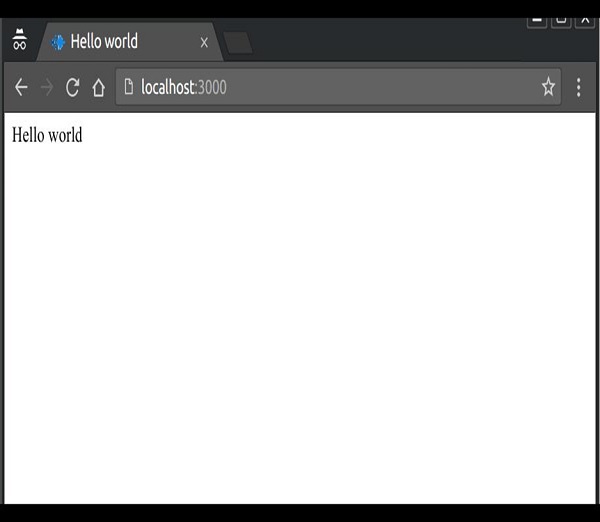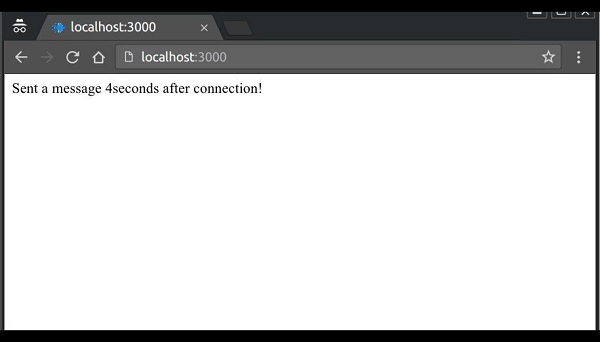
- Socket.IO Tutorial
- Socket.IO - Home
- Socket.IO - Overview
- Socket.IO - Environment
- Socket.IO - Hello world
- Socket.IO - Event Handling
- Socket.IO - Broadcasting
- Socket.IO - Namespaces
- Socket.IO - Rooms
- Socket.IO - Error Handling
- Socket.IO - Logging & Debugging
- Socket.IO - Internals
- Socket.IO - Chat Application
- Socket.IO Useful Resources
- Socket.IO - Quick Guide
- Socket.IO - Useful Resources
- Socket.IO - Discussion
Socket.IO - Event Handling
Sockets work based on events. There are some reserved events, which can be accessed using the socket object on the server side.
These are −
- Connect
- Message
- Disconnect
- Reconnect
- Ping
- Join and
- Leave.
The client-side socket object also provides us with some reserved events, which are −
- Connect
- Connect_error
- Connect_timeout
- Reconnect, etc.
Now, let us see an example to handle events using SocketIO library.
Example 1
In the Hello World example, we used the connection and disconnection events to
log when a user connected and left. Now we will be using the message event to
pass message from the server to the client. To do this, modify the io.on
('connection', function(socket)) as shown below –var app =
require('express')();
var http = require('http').Server(app);
var io = require('socket.io')(http);
app.get('/', function(req, res){
res.sendFile('E:/test/index.html');
});
io.on('connection', function(socket){
console.log('A user connected');
// Send a message after a timeout of 4seconds
setTimeout(function(){
socket.send('Sent a message 4seconds after connection!');
}, 4000);
socket.on('disconnect', function () {
console.log('A user disconnected');
});
});
http.listen(3000, function(){
console.log('listening on *:3000');
});
This will send an event called message(built in) to our client, four seconds after the client connects. The send function on socket object associates the 'message' event.
Now, we need to handle this event on our client side, to do so, replace the contents of the index.html page with the following −
<!DOCTYPE html>
<html>
<head><title>Hello world</title></head>
<script src="/socket.io/socket.io.js"></script>
<script>
var socket = io();
socket.on('message', function(data){document.write(data)});
</script>
<body>Hello world</body>
</html>
We are now handling the 'message' event on the client. When you go to the page in your browser now, you will be presented with the following screenshot.

After 4 seconds pass and the server sends the message event, our client will handle it and produce the following output −

Note − We sent a string of text here; we can also send an object in any event.
Message was a built-in event provided by the API, but is of not much use in a real application, as we need to be able to differentiate between events.
To allow this, Socket.IO provides us the ability to create custom events. You can create and fire custom events using the socket.emit function. Following code emits an event called testerEvent −
var app = require('express')();
var http = require('http').Server(app);
var io = require('socket.io')(http);
app.get('/', function(req, res){
res.sendFile('E:/test/index.html');
});
io.on('connection', function(socket){
console.log('A user connected');
// Send a message when
setTimeout(function(){
// Sending an object when emmiting an event
socket.emit('testerEvent', { description: 'A custom event named testerEvent!'});
}, 4000);
socket.on('disconnect', function () {
console.log('A user disconnected');
});
});
http.listen(3000, function(){
console.log('listening on localhost:3000');
});
To handle this custom event on client we need a listener that listens for the event testerEvent. The following code handles this event on the client −
<!DOCTYPE html>
<html>
<head><title>Hello world</title></head>
<script src="/socket.io/socket.io.js"></script>
<script>
var socket = io();
socket.on('testerEvent', function(data){document.write(data.description)});
</script>
<body>Hello world</body>
</html>
This will work in the same way as our previous example, with the event being testerEvent in this case. When you open your browser and go to localhost:3000, you'l be greeted with −
Hello world
After four seconds, this event will be fired and the browser will have the text changed to −
A custom event named testerEvent!
Example 2
We can also emit events from the client. To emit an event from your client, use the emit function on the socket object.
<!DOCTYPE html>
<html>
<head><title>Hello world</title></head>
<script src="/socket.io/socket.io.js"></script>
<script>
var socket = io();
socket.emit('clientEvent', 'Sent an event from the client!');
</script>
<body>Hello world</body>
</html>
To handle these events, use the on function on the socket object on your server.
var app = require('express')();
var http = require('http').Server(app);
var io = require('socket.io')(http);
app.get('/', function(req, res){
res.sendFile('E:/test/index.html');
});
io.on('connection', function(socket){
socket.on('clientEvent', function(data){
console.log(data);
});
});
http.listen(3000, function(){
console.log('listening on localhost:3000');
});
So, now if we go to localhost:3000, we will get a custom event called clientEvent fired. This event will be handled on the server by logging −
Sent an event from the client!